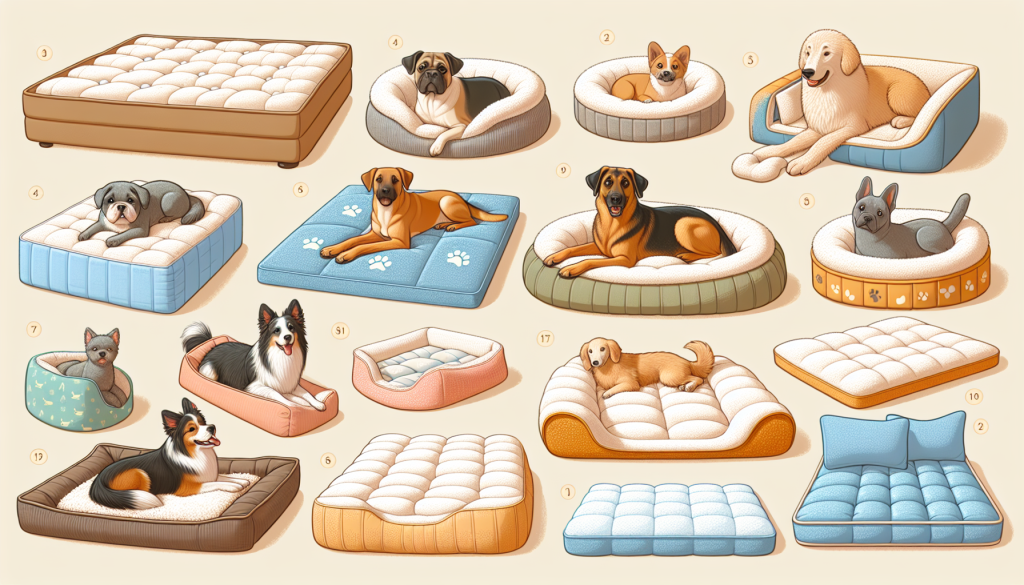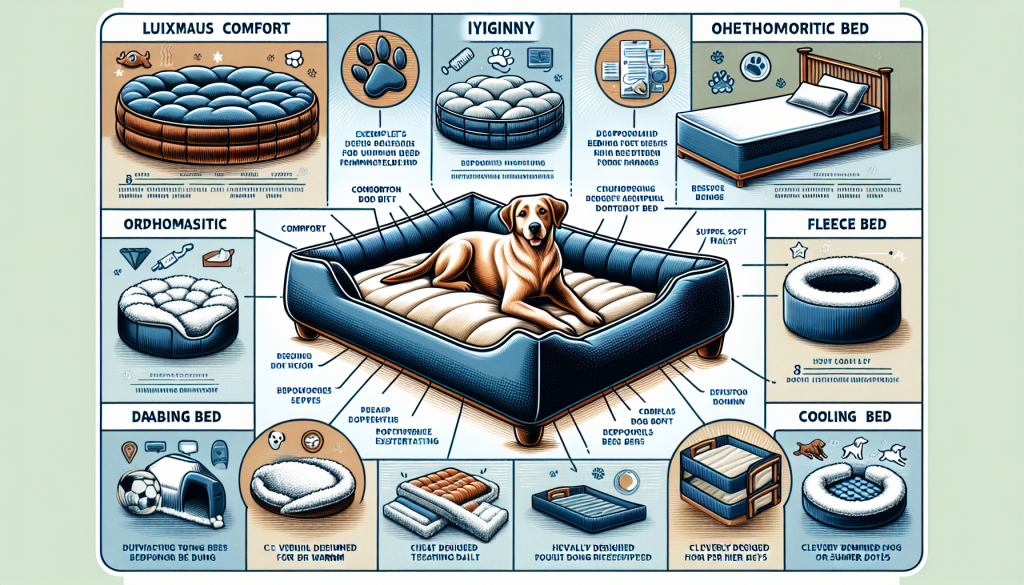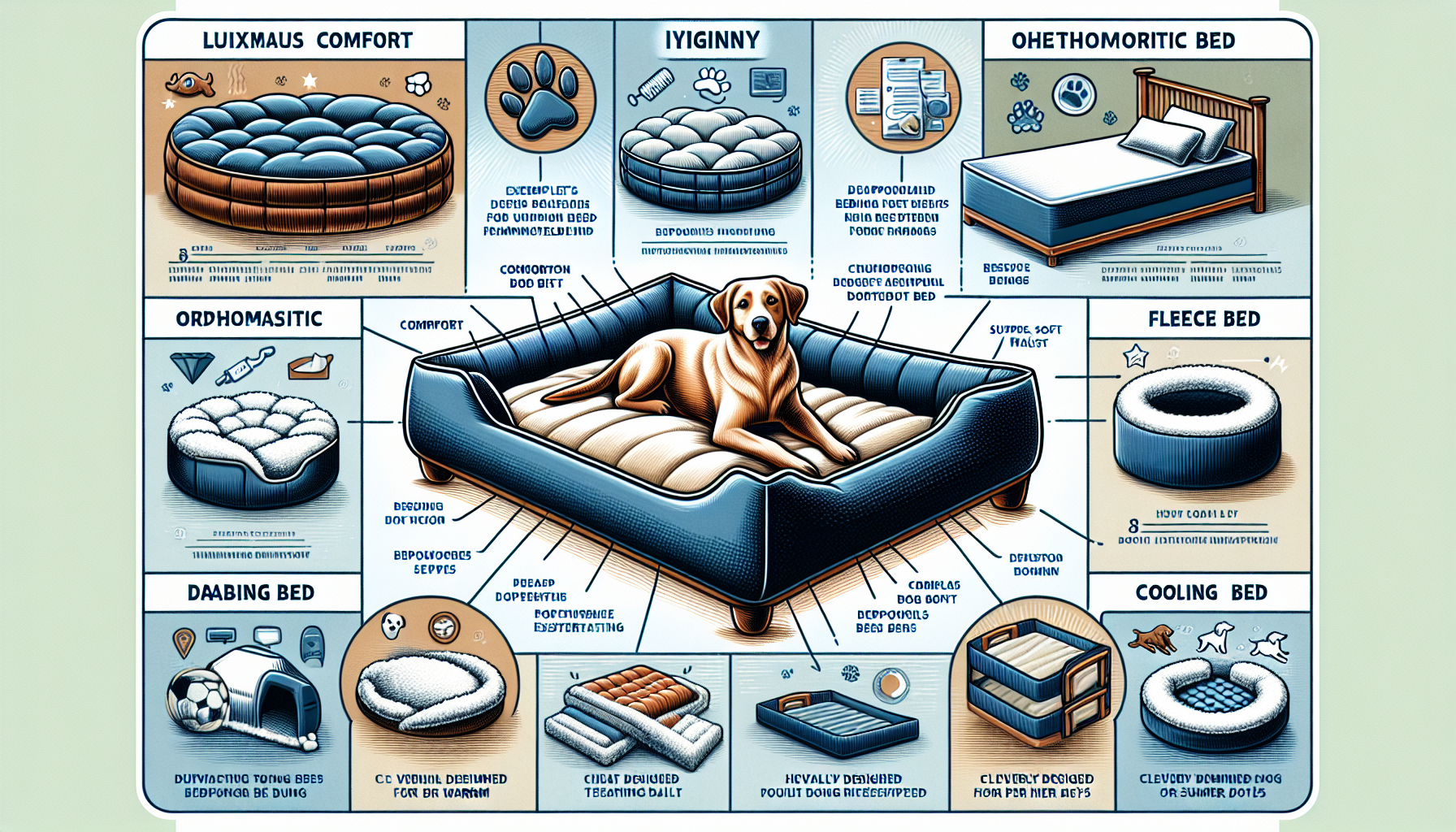Imagine snuggling up in bed with your furry companion, feeling their warmth and hearing their contented snores. But wait, there’s one crucial aspect missing- the perfect bedding for your dog! Whether your four-legged friend prefers plushness or prefers a cooler surface, finding the ideal bedding can greatly enhance their sleeping experience. In this article, we will explore various options and guide you towards selecting the best bedding for dogs in bed, ensuring your beloved pup gets the restful sleep they deserve.
Choosing the Right Bedding Material
Consider Your Dog’s Sleep Style
When it comes to choosing the right bedding material for your dog, it’s important to consider their sleep style. Some dogs prefer to curl up in a ball, while others like to stretch out and take up as much space as possible. Understanding your dog’s sleep style will help you determine the type of bedding material that will provide them with the most comfort and support.
Understanding Different Bedding Materials
There are various bedding materials available for dogs, each with its own set of benefits and considerations. It’s important to understand the different types of materials to choose the one that best suits your dog’s needs.
Natural Fibers
Natural fiber bedding materials, such as cotton, hemp, and bamboo, are great options for dogs with sensitive skin or allergies. These materials are breathable, hypoallergenic, and gentle on the skin. They also have moisture-wicking properties, which can help keep your dog cool and dry during hot weather.
Synthetic Fibers
Synthetic bedding materials, such as polyester and nylon, are known for their durability and water resistance. They are also easy to clean and maintain. However, some synthetic materials may not be as breathable as natural fibers, so they may not be the best choice for dogs who tend to overheat.
Orthopedic Foam
Orthopedic foam bedding is designed to provide extra support and comfort for dogs with joint or muscle issues, as well as older dogs. This type of bedding helps distribute your dog’s weight evenly, reducing pressure on their joints and providing relief from pain. It’s an excellent choice for dogs with arthritis or other orthopedic conditions.
Waterproof Materials
If your dog is prone to accidents or frequently gets wet, consider choosing bedding with waterproof materials. These materials are moisture-resistant and will prevent any liquids from seeping into the bed, keeping it clean and odor-free.
Allergenic Considerations
If you or a family member has allergies, it’s important to choose bedding materials that are hypoallergenic and easy to clean. Avoid materials that trap allergens, such as dust or pet dander, as they can trigger allergies and cause discomfort for both you and your dog.
Temperature Regulation
Consider the climate and your dog’s temperature preferences when choosing bedding material. Some materials, like fleece, provide warmth and insulation during cold weather, while others, like mesh or lightweight fabrics, allow for better air circulation and cooling during hot weather.
Durability and Ease of Cleaning
Dogs can be messy, so it’s important to choose bedding materials that are easy to clean and can withstand wear and tear. Look for materials that are machine washable and have durable stitching to ensure your dog’s bedding lasts for a long time.
Cost and Budget
Lastly, consider your budget when choosing bedding for your dog. While high-quality materials may be more expensive initially, they can save you money in the long run as they tend to last longer. However, there are also affordable options available that still offer comfort and durability for your furry friend.
Finding the Perfect Size Bed
Measuring Your Dog
To find the perfect size bed for your dog, it’s important to measure them accurately. Measure your dog from the tip of their nose to the base of their tail, and from the top of their head to the ground. These measurements will give you a good estimate of the length and height of the bed your dog needs.
Choosing the Right Size Bed
Once you have the measurements, choose a bed that is slightly larger than your dog’s measurements. This will ensure that your dog has enough space to stretch out comfortably and is not cramped. If your dog is still growing, consider getting a bed that can accommodate their expected adult size to save money in the long run.

Bedding Options for Different Dog Breeds
Small Breeds
For small breeds, such as Chihuahuas or Dachshunds, consider beds that offer extra cushioning and support. Look for beds with bolstered sides or orthopedic foam to provide comfort and relief for their small frames.
Medium Breeds
Medium-sized breeds, like Beagles or Border Collies, can benefit from beds that offer a good balance of support and space. Look for beds with medium thickness and size, ensuring they have enough room to stretch out comfortably.
Large Breeds
For large breeds, such as Labradors or German Shepherds, choose beds that are specifically designed for their size. Look for beds with ample padding and support, as well as sturdy construction to withstand their weight.
Giant Breeds
Giant breeds, like Great Danes or Mastiffs, require extra-large beds with strong support and durability. Look for beds that are designed to accommodate their size and weight, providing them with enough space to stretch out fully.
Additional Features and Considerations
Non-Slip Bottom
To prevent the bed from sliding around on smooth surfaces, choose a bed with a non-slip bottom. This will provide stability and ensure your dog feels secure while resting or sleeping.
Removable and Washable Covers
Opt for beds with removable and washable covers for easy cleaning. Being able to remove and wash the covers regularly will help keep the bed fresh, free of odors, and hygienic for your dog.
Chew-Resistant Fabrics
If your dog is prone to chewing or scratching, consider beds with chew-resistant fabrics. These fabrics are designed to withstand your dog’s chewing habits, reducing the risk of damage to the bed.
Odor Control
Some bedding materials have built-in odor control properties, which can help keep your dog’s bed smelling fresh. Look for beds that incorporate odor-resistant technology or are treated with antimicrobial agents to prevent the buildup of bacteria and odors.
Color and Design Options
While not essential for your dog’s comfort, choosing a bed that matches your home decor or reflects your dog’s personality can be a fun and stylish option. Many beds come in a variety of colors and designs, allowing you to find the perfect bed that suits both your dog’s needs and your personal preferences.

Providing Comfort for Special Needs Dogs
Arthritic or Elderly Dogs
For arthritic or elderly dogs, it’s important to prioritize comfort and support. Look for orthopedic foam beds that provide extra cushioning and joint relief. Beds with low entrances or ramps can also help dogs with mobility issues access their beds more easily.
Dogs with Skin or Allergy Issues
If your dog has skin or allergy issues, choose bedding materials that are hypoallergenic and gentle on the skin, such as natural fibers. Avoid materials that can trap allergens, like dust or pet dander, and opt for washable covers that can be cleaned regularly.
Anxiety or Nervous Dogs
For anxious or nervous dogs, consider beds that provide a safe and secure environment. Look for beds with raised sides or enclosed designs that mimic the feeling of a den. These types of beds can help your dog feel more comfortable and secure.
Incontinent Dogs
If your dog is incontinent or prone to accidents, choose bedding with waterproof materials. These materials will prevent any liquids from seeping into the bed, keeping it clean and odor-free. Look for beds with removable and washable covers for easy cleanup.
DIY Bedding Options
Old Pillows or Cushions
If you’re looking for a budget-friendly option, consider repurposing old pillows or cushions as makeshift bedding for your dog. Simply cover them with a washable sheet or pillowcase to provide a clean and comfortable sleeping surface.
Foam Mattress Toppers
Foam mattress toppers can be cut to size and used as dog bedding. These toppers offer extra cushioning and support and can be easily cleaned or replaced when necessary.
Upcycled Materials
Get creative and upcycle old blankets or clothing to create a cozy and personalized bed for your dog. By repurposing materials you already have, you can give your dog a unique and environmentally-friendly bedding option.
Customized Dog Beds
If you have specific requirements for your dog’s bed, consider customizing one to meet their needs. Many retailers offer custom-made beds, allowing you to choose the size, material, and design that best suits your dog.
Maintaining and Cleaning Dog Bedding
Regular Washing Schedule
To keep your dog’s bedding clean and hygienic, establish a regular washing schedule. Bed covers should be washed at least once a week, while the bed itself can be spot cleaned as needed or washed according to the manufacturer’s instructions.
Vacuuming and Spot Cleaning
In addition to regular washing, vacuuming and spot cleaning your dog’s bedding can help remove loose hair, dirt, and debris. This will keep the bed fresh and extend its lifespan.
Dealing with Stains and Odors
For stubborn stains or odors, use pet-friendly stain removers or deodorizers. It’s important to choose products that are safe for your dog and won’t cause any skin irritations or allergic reactions.
Bedding Replacement
Over time, your dog’s bedding may become worn out or lose its shape. It’s important to regularly assess the condition of the bed and replace it when necessary. Signs that it’s time for a new bed include flattened padding, ripped covers, or signs of wear and tear.
Considering Your Dog’s Sleeping Habits
Preferred Sleeping Positions
Observe your dog’s preferred sleeping positions to determine the type of bed that will suit them best. Some dogs love to curl up, while others prefer to sprawl out or sleep on their backs. Choosing a bed that accommodates their preferred sleeping position will ensure their comfort.
Burrowers and Nesters
If your dog loves to burrow or nest, opt for beds with built-in blankets or covers. These types of beds provide a cozy and secure environment that simulates digging or burrowing in the wild.
Dogs that Stretch Out
If your dog tends to stretch out when they sleep, choose beds that offer ample space. Look for large or extra-large beds that allow them to stretch their legs and fully relax.
Back Sleepers
For dogs that enjoy sleeping on their backs, choose beds with good padding and support. Look for beds that offer enough cushioning for their spine and hips to prevent discomfort.
Couch and Human Bed Sleepers
If your dog has a habit of sleeping on the couch or your bed, consider getting them a bed that mimics the feel of these surfaces. Look for orthopedic or memory foam beds that provide the same level of comfort as your furniture.
Special Considerations for Puppies
Safety and Comfort
Puppies have unique needs when it comes to bedding. Make sure to choose a bed that is safe for puppies and free of any small parts they could swallow. Bedding should also provide comfort and support as their bodies are still developing.
Potty Training and Waterproof Bedding
Puppies are still in the process of potty training, so it’s important to choose bedding with waterproof materials. Accidents are bound to happen, and having a bed that is easy to clean and dries quickly will make the potty training process easier.
Bedding with Chew-Resistant Features
Puppies love to chew, so consider bedding with chew-resistant features to prevent damage. Look for beds with reinforced stitching or materials specifically designed to withstand teething and chewing.
Growth and Size Considerations
Remember that puppies grow quickly, so choose a bed that can accommodate their expected adult size. Investing in a larger bed can save you money in the long run as you won’t have to replace it as your puppy grows.
Conclusion and Final Thoughts
Choosing the right bedding for your dog is essential for their comfort and well-being. Consider your dog’s sleep style, size, and specific needs when selecting the type of bedding material that will suit them best. From natural fibers to synthetic materials, there are various options to choose from. Additional features such as non-slip bottoms, removable and washable covers, and chew-resistant fabrics can enhance your dog’s sleeping experience. Don’t forget to consider special considerations for puppies and dogs with specific needs. By selecting the right bedding and maintaining it properly, you can ensure that your dog has a comfortable and restful place to sleep.
